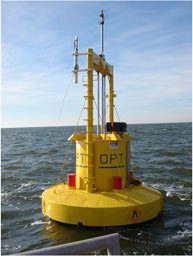 The developers of what once was billed the “world’s largest” wave energy project – to be built off Portland in Victoria – have abandoned the idea, saying it is not commercially viable.
The developers of what once was billed the “world’s largest” wave energy project – to be built off Portland in Victoria – have abandoned the idea, saying it is not commercially viable.
US-company Ocean Power Technologies has given up on plans to develop the 19MW wave energy project, which was to cost $232 million and which the Australian government had offered $66.5 million in funding support.
The decision to give ARENA a “notice of termination” follows numerous reports out of the US about the sacking of its CEO Charles Dunleavy and questions about its ability to raise finance.
The decision by the Martin Ferguson’s Department of Energy in 2009 to pick the OPT project as a candidate for funding in 2009 raised eyebrows at the time, particularly because Australian based technologies were overlooked.
Even back in 2009, I wrote in the now defunct Greenchip column in The Australian newspaper that OPT had been accused of being unable to deliver on its own projects.
“OPT was criticised by Collins Stewart, its sponsoring broker on London’s Alternative Investment Market, last year because of delays and cost over-runs at a wave project in Spain.
“Collins Stewart broker Raymoned Greaves told The Times last July that OPT had a “total inability to deliver” on projects. “The continued delays baffle us,” he was quoted as saying.
“Ironically, OPT has been commissioned to build the project at Portland, where an earlier version of its PowerBuoy technology was scrapped after part of the machine snapped off while being towed into place by an ocean tug in 2002. That installation was funded by the Victorian and federal governments.
George Taylor, the 75-year-old Australian-born electrical engineer who heads OPT, insisted at the time that the issues had been resolved.
But doubts about the project continued, despite OPT twice releasing more or less the same statement about bringing on board US defence giant Lockheed Martin as an advisor on the project.
In February, it renegotiated its timetable with ARENA and said it would start with a 2.5MW demonstration project, but not before it had done an “underwater” survey of the sea-bed. It seems it didn’t even get round to finding a snorkel.
The money allocated by the government is not lost. ARENA, which is now managing the project, only handed out $5.6 million, and it insists that this will be returned by OPT by the local subsidiary, Victorian Wave Partners, in which Woodside Petroleum was a 12 per cent shareholder. OPT said in a statement: “The parties are currently discussing how the repayment will be made.”
The question remains, however, whether the $66.5 million money will be made available for other projects being considered by ARENA, or siphoned back into the Federal budget. That will likely depend on what happens to the ARENA repeal act.
Meanwhile, the perils of wave energy technology have been further highlighted by the recent collapse of Oceanlinx, which had received $4.4 million in funds from ARENA last year for a 1MW demonstration project.
However, the huge machine foundered while being towed to its location in South Australia and had to be abandoned, forcing the company into receivership.
Australia, however, has huge resources of wave energy. CSIRO in 2012 said that enough could be exploited to provide more than 10 per cent of the country’s needs. And could power a city the size of Melbourne.
Carnegie is by far the most advanced wave energy company, with the Garden Island project featuring CETO 5 technology nearly completed, and plans starting for a demonstration of its full-scale CETO 6 technology at a nearby location, and in the UK.
Still, some politicians hold out unreasonable expectations of the technology. South Australian independent Nick Xenophon, for example, wants to restrict the amount of wind energy and solar developments under the renewable energy target so that capacity can be “reserved” for base load technologies such as geothermal and wave energy.
These technologies will likely deliver in large scale over time, but not by the 2020 timeframe that defines the renewable energy target. First of their type projects are best funded by the likes of ARENA and the CEFC.
OPT tumbled 23 per cent to $US1.18 at the close in New York on Tuesday, the lowest since its U.S. initial public offering in 2007, Bloomberg reported.








